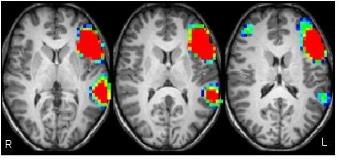READING AND LANGUAGE LATERALIZATION IN PEDIATRIC TEMPORAL LOBE EPILEPSY: AN FMRI STUDY
Abstract number :
2.415
Submission category :
Year :
2014
Submission ID :
1868967
Source :
www.aesnet.org
Presentation date :
12/6/2014 12:00:00 AM
Published date :
Dec 4, 2014, 06:00 AM
Authors :
Dror Kraus, Ravindra Arya, Jeffrey Tenney, Hansel Greiner, James Leach, Claudio Toro-serey, Jennifer Vannest and Tzipi Horowitz-Kraus
Rationale: Reading disabilities (RDs) affect up to 30% of patients with childhood epilepsy. Although the temporal lobe plays a pivotal role in the language network that supports reading, children with temporal lobe epilepsy (TLE) do not seem to perform worse on reading tests than children with other types of epilepsy. Verb-generation is a validated task used in clinical fMRI protocols for epilepsy pre-surgical evaluation. It has been shown to correlate with reading performance, probably through neural circuits supporting cognitive control. In this study, we aimed to examine the association between reading scores and fMRI lateralization of reading-related neural circuits to test the hypothesis that aberrant organization of these networks underlies RD in children with TLE. Methods: Participants: Data of two right-handed female subjects were retrospectively reviewed. The clinical characteristics are given in table 1. Functional Magnetic Resonance Imaging (fMRI): We examined regional changes in BOLD signal during a verb-generation task. EPI and 3D T1 images were collected using a 3T MRI scanner as part of a routine pre-surgical workup. Verb generation task: Stimuli were presented at a rate of one noun prompt every 5 sec, with 6 nouns presented during each 30-sec epoch. Subjects were instructed to covertly generate verbs associated with the noun prompts. Four regions of interest (ROIs, bilateral frontal and temporal regions) were selected for each subject (see figure 1). Lateralization indices (LIs) were calculated for each subject and each ROI. Behavioral measures: Full scale IQ (WISC-4), verbal ability (PPVT) and reading ability (‘letter-word identification' subtest, Woodcock-Johnson-III, WJ-III) were obtained as part of the pre-surgical workup. Results: Subject A demonstrated below-average reading scores with right lateralized temporal activation and a slightly left lateralized frontal activation. Subject B showed average reading scores and complete left temporal and frontal lateralization (see table 1). Conclusions: Subject B had ""typical"" left language lateralization and achieved higher reading scores despite a left-sided seizure onset zone. This result is in line with previous experimental and theoretical data. Epilepsy onset prior to formal reading acquisition, longer duration of epilepsy or larger seizure burden did not seem to affect language lateralization. Subject A helps to generate a hypothesis that reading-related networks may lack redundancy, as evidenced by poor reading proficiency with atypical temporal lateralization, even with slight left frontal activation. This finding might have been confounded by the subject's global cognitive dysfunction. These results serve as a proof of concept for a larger scale study to determine the effect of TLE on reading abilities and on reading-related neural networks. They provide preliminary evidence about the association between atypical organization of these networks and RD in children with intractable TLE, an important comorbidity that would warrant appropriate remedial interventions.
